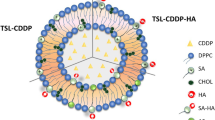Abstract
Structural and functional characteristics of various systems for delivery of antitumor preparation doxorubicin were compared. Two types of delivery systems were studied: submicron porous calcium carbonate cores coated with a polyanion (sodium dextran sulfate) and nanoparticles based on random amphiphilic copolymers of different amino acids. Scanning and transmission electron microscopy, dynamic light scattering were used to determine sizes of both delivery systems and electrokinetic potentials of their surfaces. Toxicity of delivery systems containing from 0 to 5 µg/mL of doxorubicin against MCF7 tumor cells was determined from the results of measurements of electric impedance of microsensors in the unit containing the cells and the tested delivery systems. Time-concentration profiles of doxorubicin in rat blood plasma after intraperitoneal administration of the tested delivery systems were obtained by high performance liquid chromatography. These profiles indicate considerable differences in the processes of penetration of carriers of various sizes into bloodstream.



Similar content being viewed by others
REFERENCES
F. Bray, J. Ferlay, I. Soerjomataram, P. Siegel, L. A. Torre, and A. Jemal, Ca-Cancer J. Clin. 68, 394 (2018). https://doi.org/10.3322/caac.21492
I. S. Basin, Probl. Pract. Oncol. 9, 216 (2008).
B. Gao, J. Luo, Y. Liu, S. Su, S. Fu, X. Yang, and B. Li, Int. J. Nanomed. 6, 4073 (2021). https://doi.org/10.2147/IJN.S308057
G. Minotti, P. Menna, E. Salvatorelli, G. Cairo, and L. Gianni, Pharmacol. Rev. 56, 185 (2004). https://doi.org/10.1124/pr.56.2.6
B. Matyszewska, Surf. Innovations 2, 201 (2014). https://doi.org/10.1680/si.13.00040
Y. Jiang, Y. Zhou, C. Zhang, and T. Fang, Int. J. Nanomed. 15, 3319 (2020). https://doi.org/10.2147/IJN.S249144
U. Ruman, S. Fakurazi, M. Masarudin, and M. Hussein, Int. J. Nanomed. 15, 1437 (2020). https://doi.org/10.2147/IJN.S236927
N. Yokomichi, T. Nagasawa, A. Coler-Reilly, H. Suzuki, Y. Kubota, R. Yoshioka, A. Tozawa, N. Suzuki, and Y. Yamaguchi, Hum. Cell 26, 8 (2013). https://doi.org/10.1007/s13577-012-0057-0
D. Volodkin, A. Petrov, M. Prevot, and G. Sukhorukov, Langmuir 20, 3398 (2004). https://doi.org/10.1021/la036177z
N. Zashikhina, V. Sharoyko, M. Antipchik, I. Tarasenko, Y. Anufrikov, A. Lavrentieva, T. Tennikova, and E. Korzhikova-Vlakh, Pharmaceutics 11, 27 (2019). https://doi.org/10.3390/pharmaceutics11010027
M. Dizaj, M. Barzegar-Jalali, M. Zarrintan, K. Adibkia, and F. Lotfipour, Expert Opin. Drug Delivery 12, 1649 (2015). https://doi.org/10.1517/17425247.2015.1049530
R. Mydin, I. Zahidi, N. Ishak, N. Ghazali, S. Moshawih, and S. Siddiquee, Malays. J. Med. Health Sci. 14, 201 (2018).
A. Trofimov, A. Ivanova, M. Zyuzin, and A. Timin, Pharmaceutics 10, 167 (2018). https://doi.org/10.3390/pharmaceutics10040167
Y. Svenskaya, B. Parakhonskiy, A. Haase, V. Atkin, E. Lukyanets, D. Gorin, and R. Antolini, Biophys Chem. 182, 11 (2013). https://doi.org/10.1016/j.bpc.2013.07.006
N. N. Sudareva, O. M. Suvorova, I. I. Tarasenko, N. N. Saprykina, N. V. Smirnova, S. G. Petunov, A. S. Radilov, A. S. Timin, E. G. Korzhikova-Vlakh, and A. D. Vilesov, Mendeleev Commun. 30, 25 (2020). https://doi.org/10.1016/j.mencom.2020.01.008
P. V. Binevski, N. G. Balabushevich, V. I. Uvarova, A. S. Vikulina, and D. Volodkin, Colloids Surf., B 181, 437 (2019). https://doi.org/10.1016/j.colsurfb.2019.05.077
M. Dizaj, S. Sharifi, E. Ahmadian, A. Eftekhari, K. Adibkia, and F. Lotfipour, Expert Opin. Drug Delivery 16, 331 (2019). https://doi.org/10.1080/17425247.2019.1587408
A. Som, R. Raliya, L. Tian, W. Akers, J. Ippolito, S. Singamaneni, P. Biswas, and S. Achilefu, Nanoscale 8, 12639 (2016). https://doi.org/10.1039/C5NR06162H
P. V. Popryadukhin, N. N. Sudareva, O. M. Suvorova, G. Yu. Yukina, E. G. Sukhorukova, N. N. Saprykina, O. V. Galibin, and A. D. Vilesov, Cell. Ther. Transplant. 9, 78 (2020). https://doi.org/10.18620/ctt-1866-8836-2020-9-4-78-84
N. N. Zashikhina, M. V. Volokitina, V. A. Korzhikov-Vlakh, I. I. Tarasenko, A. Lavrentieva, T. Scheper, E. Rhuel, R. V. Orlova, T. B. Tennikova, and E. G. Korzhikova-Vlakh, Eur. J. Pharm. Sci. 109, 1 (2017). https://doi.org/10.1016/j.ejps.2017.07.022
N. Sudareva, O. Suvorova, N. Saprykina, N. Smirnova, P. Bel’tyukov, S. Petunov, A. Radilov, and A. Vilesov, J. Microencapsulation 35, 619 (2018). https://doi.org/10.1080/02652048.2018.1559247
Y. Harahap, P. Ardiningsih, A. C. Winarti, and D. J. Purwanto, Drug Design, Devel. Therapy 14, 3469 (2020). https://doi.org/10.2147/DDDT.S251144
Funding
The work was performed within the framework of budget-supported research project no. АААА-А20-120022090044-2, Institute of Macromolecular Compounds, RAS.
Author information
Authors and Affiliations
Corresponding author
Ethics declarations
COMPLIANCE WITH ETHICAL STANDARDS
The experiments involving laboratory animals were performed in accordance with the regulations for using experimental animals (principles of European Convention (Strasbourg, 1986) and the Declaration of Helsinki developed by the World Medical Association concerning humane treatment of animals (1996)).
CONFLICT OF INTERESTS
Authors declare no conflicts of interests.
Rights and permissions
About this article
Cite this article
Sudareva, N.N., Suvorova, O.M., Korzhikova-Vlakh, E.G. et al. Comparison of Delivery Systems for Chemotherapy Preparation Doxorubicin using Electron Microscopic and Hydrodynamic Methods. Tech. Phys. 67, 277–282 (2022). https://doi.org/10.1134/S1063784222050103
Received:
Revised:
Accepted:
Published:
Issue Date:
DOI: https://doi.org/10.1134/S1063784222050103




